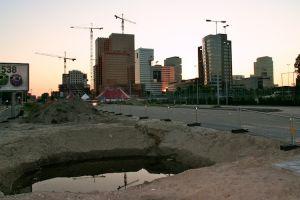Nine Visions on the City
Western Harbour District –Temporarily Open as Strategy
office: Rietveld Landscape I Atelier de Lyon
Initiatives from talented creative professionals, researchers and subcultures will find an exhilarating temporary location along the IJ, resulting in a huge creative free port that never sleeps; an inspiration for bigger achievements.
The River IJ north bank – Experiments on Noorderveld
office: Urhahn Urban Design
Urhahn Urban Design is launching a freedom struggle for Amsterdam North, aiming ar the creation of a free state within the Free State, where inhabitants can do their thing, and that becomes a place for new collectivity.
Eastern Islands – Freedom under Threat
office: Karres and Brands
The Karres and Brands design reinforces the isolation of the eastern islands, designing walled gardens and free (thinking) places as a safe haven for artists, writers, politicians and intellectuals under threat.
Het Nieuwe Diep – The ‘Free Street’ of Amsterdam
office: ZUS
In the area around the Nieuwe Diep, Zus is proposing a “small-scale mega structure” to connect the neighborhoods, people, plants and animals. The Spinoza Promenade and the Vrijstraat (or the Rue de Descartes) will be two public streets where people can live and work – the one organic and green, the other geometric and urban.
Head of the Amstel Wedge – Landscape of Liberty
office: MUST
urban design
In MUST’s design, the Amstelscheg on the south side of Amsterdam will claim green space back from the city. In return the city will be presented with a completely new metropolitan landscaped park.


